 The FONTAGRO project “Development of Maize Lines Combining Drought Tolerance and Ear Rot Resistance as a Way to Mitigate the Effects of Climate Change and Minimize Mycotoxin Contamination” held a workshop during 11-14 September 2012 in Monteria, Colombia. The workshop was jointly organized by CIMMYT and Sergio Mejía of CORPOICA and gathered participants and collaborators from Peru, Panama, Honduras, and Colombia. The participants were trained in concepts of seed production and explored ways to link with seed companies so that quality seed products can reach farmers. They were also trained in harvesting techniques and collecting agronomic data of the validation trials.
The FONTAGRO project “Development of Maize Lines Combining Drought Tolerance and Ear Rot Resistance as a Way to Mitigate the Effects of Climate Change and Minimize Mycotoxin Contamination” held a workshop during 11-14 September 2012 in Monteria, Colombia. The workshop was jointly organized by CIMMYT and Sergio Mejía of CORPOICA and gathered participants and collaborators from Peru, Panama, Honduras, and Colombia. The participants were trained in concepts of seed production and explored ways to link with seed companies so that quality seed products can reach farmers. They were also trained in harvesting techniques and collecting agronomic data of the validation trials.
The FONTAGRO project has led to the release of two varieties combining drought tolerance and resistance to ear rots and mycotoxins which have already been registered and released in Honduras. Two additional varieties are currently in the process of being validated for release in Colombia and Nicaragua. Mycotoxins result from fungal infection of maize kernels and have detrimental health effects when contaminated grain is consumed by humans and livestock. They have the potential to cause acute and chronic health problems through direct consumption, consumption through animal products, skin contact, and inhalation. Pre- and post-harvest technologies have been an effective method of reducing mycotoxins in maize.
“Through the generous support of the Director of Corpoica Turipana, the course went on very well,” stated George Mahuku, FONTAGRO project leader. During his opening remarks, Mahuku highlighted the successes of the project in validation and distribution of maize varieties and hybrids. “The project has also made progress in creating awareness of the health hazards from mycotoxin contamination,” stated Mahuku.
Luis Narro from CIMMYT-Colombia discussed current developments in maize breeding and the genesis of hybrid maize production. Félix San Vicente, leader of International Maize Yield Consortium (IMIC)-Latin America, discussed the IMIC concept and CRPs MAIZE and WHEAT, as well as ways to channel products from this project into the CRP/IMIC concept to increase diffusion and distribution. Cesar Ruiz from Semivalle, a private seed company based in Colombia, provided insights into the seed industry and the interactions between public institutions and private seed companies, a crucial component of the project enabling improved varieties to reach farmers. Alba Arcos, a CIMMYT-Colombia PhD student, presented on doubled haploid technology and how this can be harnessed to accelerate inbred line development combining different favorable traits.
“The meeting was a success and the project has generated many products in three years, including information on the incidence and prevalence of aflatoxin and fumonisin contamination of maize. We hope that we can leverage more funding to ensure that these products are widely tested throughout Latin America,” stated Mahuku. Overall, the FONTAGRO project and its network of collaborators have generated more than 6,000 doubled haploid lines combining drought tolerance and ear rot resistance.
During the workshop, collaborators discussed next steps for the project. A possible link to leverage funding from IMIC and CRP MAIZE to continue the network of breeders, researchers, and seed companies were discussed as follow-up items. A Spanish language course on doubled haploid technology will take place at the end of November at CIMMYT headquarters in El Batán, Mexico. The workshop will draw upon the results of the Monteria workshop and promote linkages throughout the region of Latin America.
 Climate adaptation and mitigation
Climate adaptation and mitigation 
